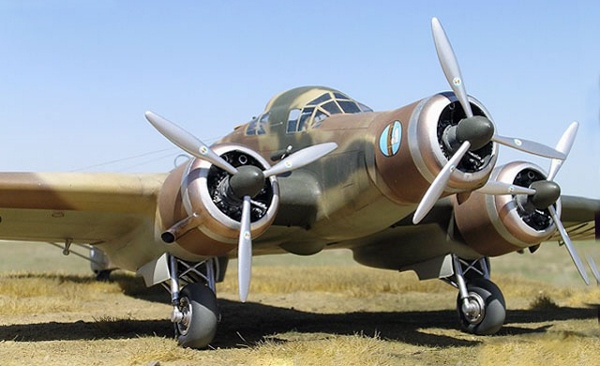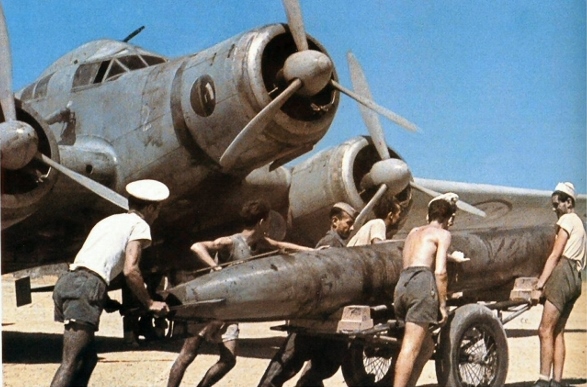
|
 |
Savoia-Marchetti SM.79 |
 |
 |
 |
 |
 |
|---|---|---|---|---|---|---|---|
 |
 |
 |
 |
 |
|||
 |
||
|
The SM.79 was originally designed as a passenger aircraft and in 1937-39, it set 26 world records to become the fastest medium bomber in the world. | ||
|
It was the most important Italian bomber of World War II, and established a reputation that contrasted with most Italian weapons of the day. SM.79s served widely in the normal bombing role, but it is as a land-based torpedo bomber that the type deserves its place in military aviation history. Regarded by many as one of the finest torpedo bombers of the war, it served with distinction and was flown with courage and skill.
Designed by Alessandro Marchetti, the prototype appeared in late 1934 as an eight-passenger aircraft. It was intended to compete in the MacRobertson London-Australia air race, but it was completed too late.1 It subsequently had a varied career, setting records and winning races with various engines. |
| The prototype made its inaugural flight on September 2, 1935, and following the Regia Aeronautica's preferred tri-motor formula, it was originally powered by three 610 hp (455 kW) Piaggio Stella radial engines, but then changed to 750 hp (560 kW) Alfa Romeo 125 RC.35 engines.2 About 1,300 production models were built over a nine year period. They had internal provision for 2,750 lb (1,250 kg) of bombs, supplemented by under-fuselage racks for a pair of heavy bombs, or two torpedoes in the case of the SM.79-II and SM.79-III. |
|
The basic design continued the company's tradition of mixed
construction with steel tubes light alloy wood and fabric (this being the only way to produce in
quantity with available skills and tools); but compared with other designs it had a much more highly loaded wing, which demanded long airstrips.
The SM.79 had a distinctive 'hump' on the upper forward fuselage, which housed both the fixed forward-firing heavy machine-gun and the dorsal gunner's position. Its appearance earned the aircraft the nickname 'Gobbo Maleditto' ('Damned Hunchback'). In spite of its cumbersome appearance and outdated steel tube/wood/fabric construction, the SM.79 was a rugged, reliable multi-role medium bomber which did quite a bit of damage in the face of heavy opposition. Developed from a civil airliner, the first Sparvieros (Sparrowhawk) entered service with the Regia Aeronautica in late 1936, just in time to fly combat over Spain with the Aviacion Legionaria, the Italian contingent fighting in support of the Nationalists. The SM.79-I established an excellent reputation in combat with the Aviacion Legionaria in Spain in 1936-1939. Its performance drew favorable comments from both sides, leading to a succession of export orders. The SM.79-I served with the Italian Aviazione Legionaria in support of Franco in the Spanish Civil War. In October 1939, the Regia Aeronautica began to receive the 79-II with 1,000 hp (745.2 kW) Piaggio P.XI RC.40 engines (one batch had the Fiat A.80 of similar power) and this was the dominant version in action subsequently. About 1,200 served with the Regia Aeronautica including a handful of the III sub-type with forward-firing 20 mm cannon and no ventral gondola.

The SM.79 was regarded by many as one of the finest torpedo bombers of the war. When Italy joined the war in 1940, its air force had nearly 1,000 bombers, of which well over half were Savoia-Marchetti S.M.79 Sparviero medium bombers. These trimotors, were thought by many to be among the best land-based torpedo bombers of the war. They could carry 2,750 lb (1,250 kg) of bombs internally or two torpedoes. Also active as a medium bomber around the Mediterranean and on anti-ship duties was the Cant Z.1007 bis Alcione (Kingfisher), production of which began in 1939. It also was a trimotor, powered by 1,000 hp (745 kW) Piaggio radials and it carried four machine guns for self-defense as well as up to 4,410 lb (2,000 kg) of bombs or two torpedoes. In the summer of 1942, Allied efforts to relieve beleaguered Malta culminated in 'Operation Pedestal', when 14 merchantmen with heavy Royal Navy escort left Gibraltar on August 10. Among the enemy aircraft sent against them were 74 Sparvieri, a number of which had already scored hits on the battleship HMS Malaya and the carrier HMS Argus. 'Pedestal' eventually got through to Malta, but at the cost of one carrier, two cruisers, a destroyer and nine merchant ships, many of them having been hit by torpedoes from the SM.79s. The more powerful SM.79-II served in North Africa, the Balkans, and Mediterranean during the Second World War, while other units called Aerosiluranti (aerial torpedoes) pioneered use of these large fast bombers in the anti-shipping role. When the Italians surrendered on September 8, 1943, it did not end the combat record of the SM.79, and a new version, the SM.79-III torpedo-bomber was placed in production by the RSI, the fascist government in northern Italy. An effective torpedo bomber as well, the SM.79 served in the air forces of Brazil, Iraq, Yugoslavia, Romania and Spain, some right up to the end of the war. The Romanians flew them on the Russian front from 1941 to 1944, an unprecedented record for an aircraft designed in the early 1930s. Though known as a tri-motor, several versions were built as twin-engine aircraft using a number of different powerplants, including Junkers 1,220 hp (910 kW) Jumo 211 D inlines. Regardless of the version, its handling pleased most pilots and its ability to come home with extensive damage endeared it even more. Used throughout North Africa and the Mediterranean until the Italian surrender in September 1943, the Sparviero remained flying with both the Italian cobelligerent forces fighting alongside the Allies and the surviving pro-Nazi units. About 100 were exported to Brazil Iraq and Romania—all of the twin-engine SM.79B variety. Romania built the 79JR under license with two 1,200 hp (894 kW) Junkers Jumo 211Da liquid-cooled engines. These were used in numbers on the Eastern Front; initially as bombers with visual aiming position in the nose and subsequently mainly as utility transports. Post-war surviving SM.79s were converted into various versions of utility transports during the last phases of the war and survived in that role until 1952.

The SM.79 had a distinctive 'hump' on the upper forward fuselage. Its appearance earned the aircraft the nickname Gobbo Maleditto, 'Damned Hunchback.' |
| Specifications: | |
|---|---|
| Savoia-Marchetti SM.79 Sparviero | |
| Dimensions: | |
| Wing span: | 66 ft 3 in (20.2 m) |
| Length: | 53 ft 2 in (16.2m) |
| Height: | 13 ft 6 in (4.1 m) |
| Weights: | |
| Empty: | 16,975 lb (7,700 kg) |
| Operational: | 25,132 lb (10,050 kg) |
| Performance: | |
| Maximum Speed: | 286 mph (460 km/h) at 12,450 ft (3,790 m) |
| Service Ceiling: | 24,600 ft (7,500 m) |
| Range: | 1,615 miles (2,600 km) |
| Powerplant: | |
|
Three 750 hp (559 kW) Alfa-Romeo 126 RC.34 radials, or three 1,000 hp (745 kW) Piaggio P.XI RC40 14-cylinder radials. Romanian built 79JR & twin-engine SM.79B, two 1,200 hp (894 kW) V-12 Junkers Jumo 211Da engines. | |
| Armament: | |
|
Three 12.7 mm Breda-SAFAT machine gun; one forward-firing gun from the cockpit hump with limits set to fire above
the nose propeller;
a second rearward-firing gun from the hump; a third gun from the gondola under the rear fuselage; and
one 7.7 mm each firing from both waist positions. This required a crew of at least
five. The bombardier occupied the gondola with his legs projecting down in
two retractable tubes during the bombing run. Bomb load of 1,200 kg (2,645 lb) carried in an internal bay; alternatively two 450 mm (17.7 in) external torpedoes. | |
Endnotes:
|
Return to Aircraft Index
©Larry Dwyer. The Aviation History Online Museum.
All rights reserved.
Created October 19, 1997. Updated January 19, 2020.